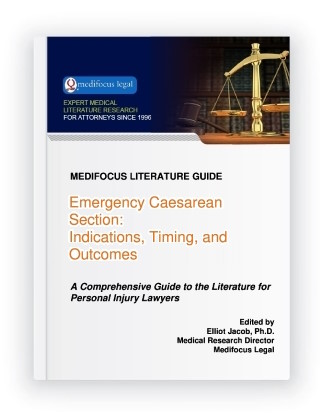Emergency Caesarean Section: Indications, Timing, and OutcomesA Comprehensive Guide to the Literature for Personal Injury Lawyers
Publisher: Medifocus Legal
Publication Date: May 28, 2025
Number of Pages: 87
A Comprehensive Guide to the Literature for Personal Injury Lawyers
Publisher: Medifocus LegalPublication Date: May 28, 2025
Number of Pages: 87
Globally, the rates of emergency C-sections vary significantly, reflecting differences in healthcare systems, obstetric practices, and maternal health profiles. According to the World Health Organization, the overall global rate of C-sections is approximately 21%, with emergency procedures constituting a substantial proportion, often around 50% of all C-sections.
The decision to perform an emergency C-section hinges on rapid assessment and timely intervention to prevent adverse outcomes such as hypoxia, brain injury, or death for the fetus, and hemorrhage, infection, or uterine rupture for the mother. The procedure involves meticulous surgical technique and prompt anesthesia administration to stabilize both patients effectively. Despite its life-saving potential, emergency C-section carries inherent risks, including surgical complications, increased blood loss, and longer recovery times.
Medical-legal implications are significant in emergency C-section cases. Consent is a central legal concern; often, urgent circumstances limit the ability to obtain comprehensive informed consent from the mother beforehand. Failure to timely perform an emergency C-section can result in allegations of negligence, especially if adverse fetal or maternal outcomes occur. Conversely, unnecessary or delayed interventions may also lead to legal repercussions. Documentation of clinical findings, decision-making processes, and communication with the patient and family is crucial in defending healthcare providers against potential litigation.
The MediFocus Literature Guide to Emergency Caesarean Section is a comprehensive guide to the medical literature for personal injury lawyers that focuses on the indications, timing, and outcomes associated with this emergency obstetric procedure. This Literature Guide includes over 100 carefully selected journal article references published over the past decade in peer-reviewed medical journals that represent the foundation for the standard of care for performing emergency C-sections.
The MediFocus Literature Guide to Emergency Caesarean Section is available as a soft-cover book or as a PDF download. When you order the soft-cover book, we also include the PDF format at no additional cost. The user-friendly PDF version of this Literature Guide enables easy access to the abstracts of each individual article. Convenient links are also included to the full-text version of each article, many of which are available as a free download.
Order your copy of The MediFocus Literature Guide to Emergency Caesarean Section today! Please see the side panel for ordering information.
 |
- A comprehensive bibliography of 119 journal article references indexed in MEDLINE published in well respected medical and scientific journals.
- Online access to the abstracts (summaries) of the articles.
- Online access to the free full-text version of 49 articles.
- Links to full-text sources of other articles that are available for purchase directly from individual journal publishers.
- A unique "Author Directory" consisting of the names and institutional affiliations of experts who have published and have specialized knowledge about Emergency Caesarean Section: Indications, Timing, and Outcomes. The "Author Directory" is a valuable resource for quickly identifying and locating experts for case reviews, opinions, and testimony.
Select examples of topics that are covered by the articles referenced in this Guidebook include:
- Impact of 'decision-to-delivery' interval on maternal and perinatal outcomes.
- Timing of emergency caesareans - what's the rush? A retrospective multi-centred observational study into decision-to-delivery interval and maternal and fetal outcomes.
- Risk factors for and consequences of difficult fetal extraction in emergency caesarean section. A retrospective registry-based cohort study.
- Analysis of medico-legal claims related to deliveries: Caesarean section vs. vaginal delivery.
- Perinatal outcomes of cases with umbilical hypocoiled cord: a study at a single perinatal center
- Determinants of the decision-to-delivery interval and the effect on perinatal outcome after emergency caesarean delivery: a cross-sectional study.
- Impacted fetal head: A retrospective cohort study of emergency caesarean section.
- Decision to delivery interval and associated factors for emergency cesarean section: a crosssectional study.
- Maternal and neonatal outcomes in planned versus emergency cesarean delivery for placenta accreta spectrum: A multinational database study.
- Medical Malpractice Liability Exposure and OB/GYN Physician Delivery Decisions.
- Maternal characteristics and neonatal outcomes of emergency repeat caesarean deliveries due to early-term spontaneous labour onset.
- Severe neonatal outcomes associated with emergency cesarean section at term.
- Evaluating the Decision-to-Delivery Interval in Emergency Cesarean Sections and its Impact on Neonatal Outcome.
- Prediction of emergency cesarean section by measurable maternal and fetal characteristics.
- Indications for, and timing of, planned caesarean section: A systematic analysis of clinical guidelines.
- Cesarean for non-reassuring fetal status: effect of obesity on decision to delivery interval.
- Brachial Plexus Birth Injury in Elective Versus Emergent Caesarean Section: A Cohort Study.
- Customised growth charts in large-for-gestational-age infants and the association with emergency caesarean section rate.
- Operating room-to-incision interval and neonatal outcome in emergency caesarean section: a retrospective 5-year cohort study.
- Decision-to-delivery interval: Is 30 minutes the magic time? What is the evidence? Does it work?
is available in two formats: | |
Order by Phone:To order by phone, please call: Order by Mail:To order by mail, please print and complete this Order Form | |

